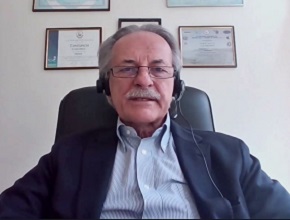Dr Derek Chu, assistant professor at the Faculty of Health Sciences at McMaster University, connects with Dr Roman Jaeschke to discuss the newly published systematic review and meta-analysis from the Journal of the American Medical Association (JAMA) (doi: 10.1001/jama.2021.7872) on the use of dual versus triple inhaler therapy in asthma.
Roman Jaeschke, MD, MSc: Good morning. Welcome to another edition of McMaster Perspective. We have with us Dr Derek Chu, who is a repeat offender—every time he publishes in The Lancet or JAMA, we try to interview him. Today we’ll be talking about… Professor Chu, why don’t you tell us what we’ll be talking about?
Derek Chu, MD, PhD: We’ll be talking about a great team effort by doctors Lisa Kim, Anna Whalen-Browne, Carol Saleh—the last 2 who are fellows in the allergy program—as well as Dr O’Byrne, whom you all know, about our recent study addressing a systematic review and meta-analysis of triple inhaler therapy, that is, inhaled corticosteroids, long-acting bronchodilators—beta2 agonists, and a muscarinic antagonist, versus a dual inhaler combination for asthma.
Roman Jaeschke: Maybe we will start by orienting both myself and our listeners in how we establish how severe asthma is?
Derek Chu: Thanks, Roman. Asthma does go along a spectrum and there are various severity classification systems around the world, whether that be Global Initiative for Asthma (GINA), the Canadian Thoracic Society, or the American version. However, in general, the same concept holds, being that the severity of asthma is defined by the intensity of therapy required to gain control of that patient’s day-to-day symptoms and exacerbations.
Roman Jaeschke: So, what are the severities, at least as of… prior to your publication, and how is the treatment being escalated?
Derek Chu: There are 3 broad categories. The first is mild asthma, then moderate to severe asthma, and then more severe asthma—things that may require prednisone dependency. And they can be divided further into, [let’s] say, the GINA classification of 1, 2, 3, 4, or 5, typically where in steps 3 to 4 patients require routine use of inhaled corticosteroids (ICS) and a long-acting beta2 agonist (LABA), so ICS and LABA, for control of their symptoms.
And the question that we set out to address is, in these patients, should we be adding an additional bronchodilator? As we know, in asthma, one major problem is the bronchoconstrictive effect and airway hyperreactivity issue that is central to the pathophysiology as well as the clinical expression of symptoms.
Roman Jaeschke: OK, and in this case, what have you found?
Derek Chu: Prior to our work there was little data and only a few thousand patients, primarily adults, for addressing this issue about whether or not to add a long-acting muscarinic antagonist (LAMA), to the ICS/LABA therapy. We were able to identify ~18 studies reporting on ~20 trials of 12,000 patients, which addressed adults, adolescents, and children, on the use of triple therapy, that is ICS, LABA, and LAMA versus ICS and LABA alone. By doing that we’ve been able to find a number of issues.
Number one is that, in contrast to previous guidelines, we actually found that there was a slight and modest reduction, a ~15% relative reduction in severe exacerbations—those are events that require hospitalization or courses of prednisone—and that this is likely highly dependent on the individual’s baseline risk for future exacerbation and [that] would dictate whether or not this would be a major factor in dictating whether or not this treatment should actually be used.
Other more common patient-important outcomes such as routine asthma control, quality of life, [and] lung function were very modestly improved, often below the minimally important difference. So, patients should not be expected to primarily benefit in these outcomes from this regard.
Lastly, we were able to show that this treatment is very safe. There’s no increase in cardiac risk and overall mortality, but there are very slight minor adverse events such as those of dry mouth or dysphonia.
Roman Jaeschke: OK, so, in terms of practical implications, how would you summarize them to people who treat asthma that is moderate or severe, ie, quite difficult to control? How did this, in practical terms, change what we do?
Derek Chu: In this case, what we’re showing is that… In contrast to recent guidelines that have suggested that triple therapy is typically used primarily to improve asthma symptoms and quality of life and not so much to reduce exacerbations, we actually show the opposite.
Instead, what this means is that there is a very modest reduction in exacerbations and therefore patients at higher risk for future exacerbation should be the primary target for using this medication rather than [it being used as a] blanket on everyone, including those at low risk for exacerbation. That being said, it is a safe therapy to use and one to keep in the armamentarium of asthma treatment, of course, keeping in mind all the other options available to treat asthma.
If you have someone who is becoming uncontrolled, you have to think about not only their current symptoms and daily burden, but also their future risk for exacerbation, as well as the alternative options of biologics, which can be very expensive, or things like allergen immunotherapy, which could be time-consuming, and lastly, about procedures, such as bronchial thermoplasty, which can be invasive.
Roman Jaeschke: OK, so maybe the last question. Did you look at the use of inhalers in separate containers versus a single container?
Derek Chu: It’s an important question, Roman, because there are many triple therapy combination inhalers—they’re all being packaged together as a single inhaler—that are being approved, being applied to be approved, or were recently approved, including new formulations of LAMAs. What we showed is a similar effect across 2 separate containers or a single container of inhaler. That allows [for] the flexibility to use a single inhaler in high-resource settings with good accessibility if that’s a patient’s preference, [while] in low-resource settings or where it’s harder to access a single inhaler, clinicians and patients can be confident in using the 2 inhalers separately to still derive the benefits.
Roman Jaeschke: OK. Dr Chu, I want to thank you very much for this practical information. I hope to meet again with your next high-level, high-impact publications. Thank you very much.
Derek Chu: Thanks so much, Roman. It’s been a pleasure.
 English
English
 Español
Español
 українська
українська










